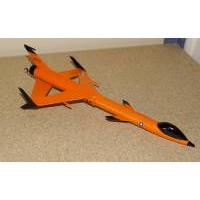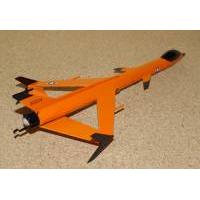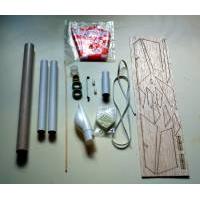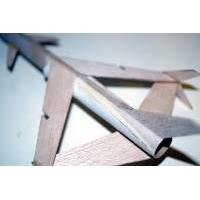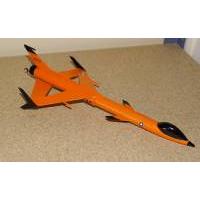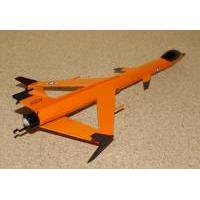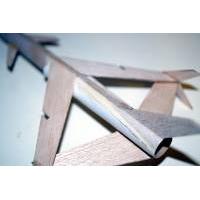| Construction Rating: | starstarstarstar_borderstar_border |
| Flight Rating: | starstarstar_borderstar_borderstar_border |
| Overall Rating: | starstarstarstar_borderstar_border |
| Published: | 2015-08-21 |
| Diameter: | 0.74 inches |
| Length: | 13.00 inches |
| Manufacturer: | Estes  |
| Skill Level: | 3 |
| Style: | Futuristic/Exotic |
 Brief
Brief
The Lynx, by Estes, is a futuristic space plane styled kit flying on mini motors. Advertised as a level 3 kit, it brings the complexity of larger and more detailed Estes kits to the 13mm motor size range. It is definitely a unique kit for a small 13mm bird.

Components
Components are standard Estes materials. The main body tube is a BT-20, with a pair of BT-5's included for the side intake details. The single balsa sheet is laser cut with a significant number of pieces. Motor mount is the standard 13mm fare... motor tube, two centering rings, hook, blocking ring, and extra sleeve to retain the motor hook. Rounding off the material is a rather distinctive nose cone with a cockpit bubble, clay weight, 1/" dowel, and decal sheet. Rather unusual for a BT-20 kit, the included recovery option is a 12" plastic parachute.
Most of the material was of typical Estes high quality, but I did find the centering rings and motor blocking ring to be very soft and crumbly compared to usual.

Construction
The honest opinion I have on this build is that it should have been marked as a level 4 kit at minimum. The majority of the build is well detailed in the instructions and easy to follow. Though the wing layout is fairly complex for a kit this size, it goes together easily if you follow along with the construction methods Estes lays out. Each stage of the build has its own little quirks to watch out for. On the motor mount I found it was much easier to glue on the provided template for locating the detail ribs. I'd also suggest measuring the actual length of those ribs instead of using the Estes provided length. Otherwise you may end up with a gap.
The tricky area to watch for is the side 'intakes' made from the BT-5 body tubes. I highly suggest making a couple of photocopies of the template before attempting to cut out the intakes. Also remember not to cut out the oval shape from the template before attaching to the BT-5's. Keep the template intact as a rectangle, tape it in place, then follow along with a new x-acto blade. If you're careful enough, you can make both intakes from a single BT-5 and have one leftover for future use. Also be ready to use a fair amount of filler, as it's hard to get a good seam, and it's particularly difficult to glue to the intakes in place evenly.


Finishing
There are a lot of nooks and crannies to watch for. No matter what technique you use, it's going to be difficult to get a highly smooth finish throughout the whole model. Particularly difficult will be the seams along where the intakes join the body, and also where the main wings join the body. Take your time and be ready to compromise on having some visible imperfections. I went with my own color scheme instead of the kit suggestion of all-black with white decals. The suggested markings are pretty sharp looking for sure, but for some reason I felt mine needed to be built like a '60's era orange target drone.
Flight
This is a low wind flier, no doubt about it. The broad wing area imparts a lot of weathercocking if there's significant wind. The suggested A3-4T for 'first flight' may be a bit weak in average impulse, the A10-3T would be a better choice for all flights. Don't be skimpy with the clay for nose weight either, as it also likes to take on a parabolic flight profile too.
Recovery
Estes made a goof on this one, they gave it a 12" parachute. Not only does it barely fit in the body tube, but it also causes quite a lot of drift in the wind between the chute size and wing area. It's likely too heavy for a standard Estes streamer, but do consider either a 9" chute or 2x20 streamer in place of the kit chute. If you do keep the kit chute, you'll need to be very careful in how you pack it. Otherwise you risk it getting stuck in the body tube.
Summary
I'm really torn over this kit. It looks great, but is tricky to build cleanly. The more punchy A10-3T will get you a great flight, but wow does the wind carry it with the included chute. It also doesn't quite fit in very well with the rest of the Estes lineup. Typically the BT-20 based kits flying mini motors are targeted towards beginners and kids. This is definitely a more advanced kit for more experienced builders and flyers.
Yet I think an experienced builder with a few tweaks could make a stellar rocket out of this kit. All the basic framework is there for a great kit, just that a few quirks hold it back.
 |
 |
Flights
Sponsored Ads
 |
 |
